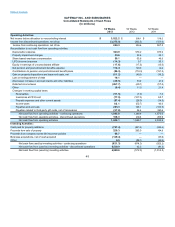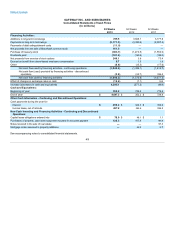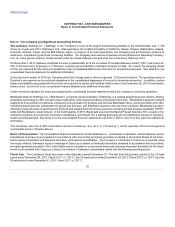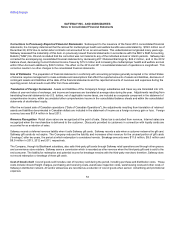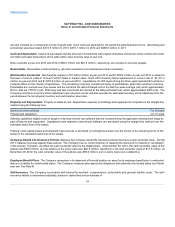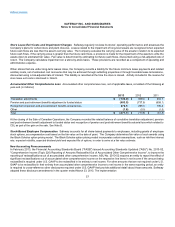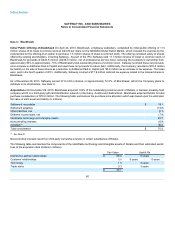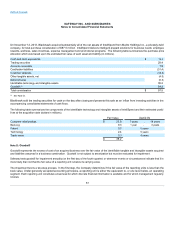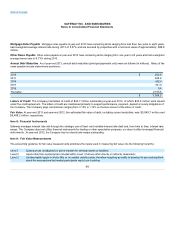Safeway 2013 Annual Report Download - page 56
Download and view the complete annual report
Please find page 56 of the 2013 Safeway annual report below. You can navigate through the pages in the report by either clicking on the pages listed below, or by using the keyword search tool below to find specific information within the annual report.
Table of Contents
judgment in estimating final outcomes. Actual results could materially differ from these estimates and could significantly affect the
Company’s effective tax rate and cash flows in future years.
Financial Instruments
Interest rate swaps. The Company has, from time to time, entered into interest rate swap agreements to change its portfolio mix of fixed-
and floating-rate debt to more desirable levels. Interest rate swap agreements involve the exchange with a counterparty of fixed- and floating-
rate interest payments periodically over the life of the agreements without exchange of the underlying notional principal amounts. The
differential to be paid or received is recognized over the life of the agreements as an adjustment to interest expense. The Company’s
counterparties have been major financial institutions.
Energy contracts. The Company has entered into contracts to purchase electricity and natural gas at fixed prices for a portion of its energy
needs. Safeway expects to take delivery of the electricity and natural gas in the normal course of business. Contracts that qualify for the
normal purchase exception under derivatives and hedging accounting guidance are not marked to market. Energy purchased under these
contracts is expensed as delivered.
Warrants. Blackhawk issued warrants to third parties to purchase shares of Blackhawk common stock. Blackhawk recorded substantially all
of the these warrants in additional paid-in-capital with an offset to intangible assets and is amortizing the assets over the term of the related
marketing and distribution services agreements of approximately five years. The value of these warrants was calculated using the Black-
Scholes model. Since there is no active market for these warrants, the valuation model used unobservable pricing inputs and management
estimates.
Fair Value of Financial Instruments Disclosures of the fair value of certain financial instruments are required, whether or not recognized
in the balance sheet. The Company estimated the fair values presented below using appropriate valuation methodologies and market
information available as of year end. Considerable judgment is required to develop estimates of fair value, and the estimates presented are
not necessarily indicative of the amounts that the Company could realize in a current market exchange. The use of different market
assumptions or estimation methodologies could have a material effect on the estimated fair values. Additionally, the fair values were
estimated at year end, and current estimates of fair value may differ significantly from the amounts presented.
The following methods and assumptions were used to estimate the fair value of each class of financial instruments:
Cash and equivalents, accounts receivable, accounts payable. The carrying amount of these items approximates fair value.
Short-term investments. These investments are readily convertible to cash and the carrying amount of these items approximates fair value.
Notes receivables. The Company's notes receivables, included in other assets, is comprised primarily of notes receivable resulting from
the sale of real estate. The fair value of note receivables is estimated by discounting expected future cash flows using interest rates, adjusted
for credit risk, at which similar loans could be made under current market conditions. The carrying value of notes receivables, which
approximates fair value, was $101.0 million at December 28, 2013 and $130.6 million at December 29, 2012.
Long-term debt, including current maturities. Market values quoted in public markets are used to estimate the fair value of publicly traded
debt. To estimate the fair value of debt issues that are not quoted in public markets, the Company uses those interest rates that are currently
available to it for issuance of debt with similar terms and remaining maturities as a discount rate for the remaining principal payments.
56




